Here's the original post, if you missed it, or want to review.
Anyway, here's the other part of that subject: if you absolutely have to break the 180 rule, here are a few ways to smooth over the transition and make it so that it doesn't confuse or jar the audience.
To review in brief: if you take these two shots of a character running from two different sides of the "line of action" and cut them together, it can confuse the audience and they may think that your character either turned around and started running the other way or that you're cutting between two different characters who are running towards each other (or away from each other).
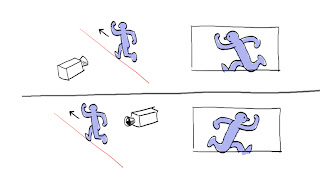
So if you absolutely have to use these two shots, how are you supposed to bridge the transition between them? There are a few common ways:
Firstly, you could place a neutral shot inbetween the two different shots. A neutral shot is one in which the character is heading either straight towards the camera or straight away from the camera, without any kind of left-to-right or right-to-left type orientation.
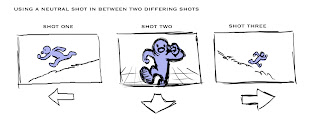
Or, if you have two shots you need to connect where the screen direction is different, you could always have a shot inbetween where the character changes the direction he's running all in one shot - in this example, the camera tracks him as he makes a u-turn, turning around and running back the way he came.
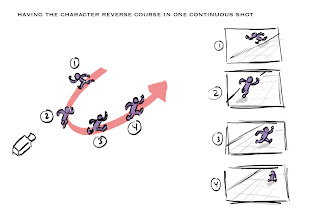
So then, all together, you'd have this:

Yet another way to do it is to cut to a wide shot on the change of screen direction. This helps smooth out the change of screen direction because the character is so small on the screen that, visually, the change of screen direction is less jarring. Also when you cut wide the audience can see more landmarks and more environment which helps the audience to orient themselves and can minimize their confusion about the change in screen direction.
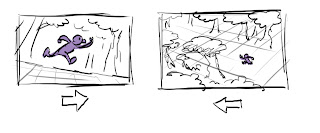
One other option that can help smooth out the change of screen direction is a match cut. When you cut from the character going one way to the character going the other way, keep them in the same place on the screen. This will help the audience's eye connect them as the same character, even though the screen direction has changed.
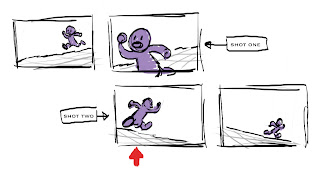
See how the character is in the same place (red arrow) in both the first and second shot? That's a match cut.
All of these are techniques that live-action movies use to edit together shots that have differing directions of screen direction. In live action, where it's common to shoot the same scene from different angles and then connect them together in the editing room, these techniques can really come in handy.
However, they aren't really that common or useful in animation. In the animation world, we are creating every environment from scratch and we plan out all of our cuts and camera moves in the storyboard and layout stage, so really there's no reason to end up with shots of different screen direction that need to be bridged together.
But in any case this topic seemed like a popular one before so I thought I would finish it up with the other side of the coin! Let me know if all of this confusing or if it all makes sense.